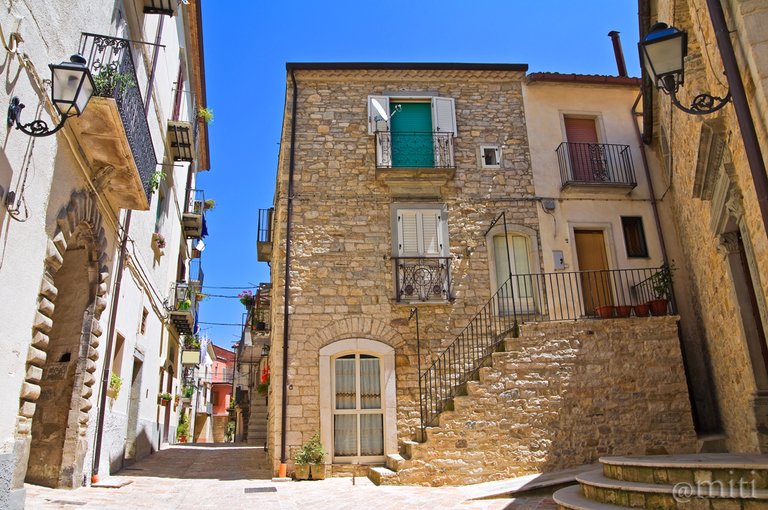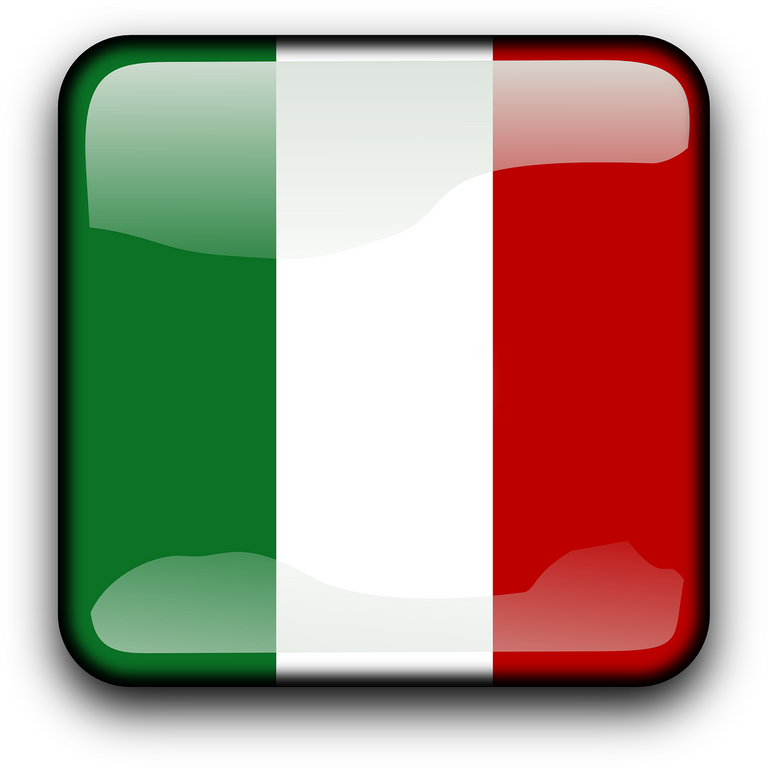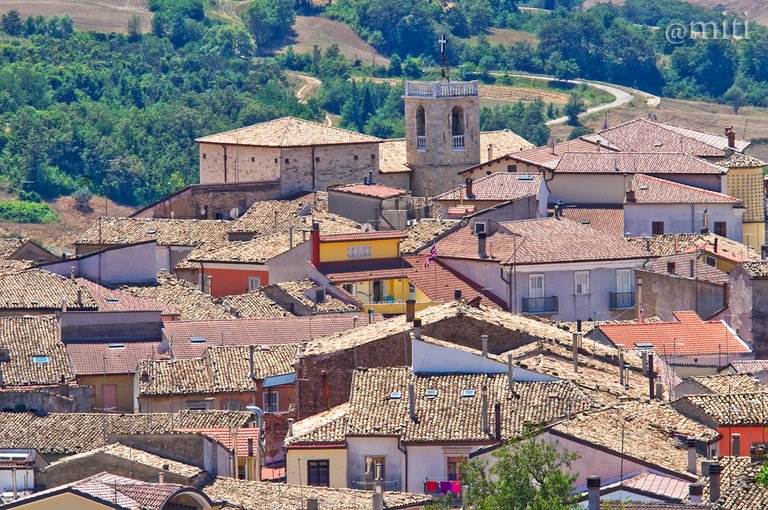
Alleyway in the historical center (Author's photo - All rights reserved)
Vicolo del centro storico (Immagine dell'autore - tutti i diritti sono riservati)



Ciao a tutti,
questo è un viaggio attraverso l'Italia. Posterò una foto al giorno con una brevissima descrizione. Spero vi piaccia!

Roseto Valfortore è un piccolo borgo della provincia di Foggia, nella regione italiana meridionale della Puglia. Si trova ai piedi dei Monti Dauni, arroccato su un pendio che scende verso la valle del fiume Fortore.
Anticamente chiamato Rosito, prende il nome dall'abbondanza di rose selvatiche nel suo territorio.
Le origini di Roseto Valfortore, sembrano risalire ai romani, dati i ritrovamenti risalenti al I secolo d.c. nel suo territorio.. Nel 752 appare per la prima volta il nome "Rosito".
Dopo essere appartenuto alla dominazione normanna della Contea di Ariano, Roseto passa a Guglielmo il Guiscardo nel 1122, duca di Puglia, in seguito ad un attacco riuscito. Nel 1294 Bartolomeo I di Capua si impiantò nel feudo di Roseto al posto di D'Assimal che lo aveva ricevuto da Carlo d'Angiò dopo la presa di Lucera. Nel 1497 Bartolomeo III, ricevuta la conferma del re feudale di Napoli Ferdinando il Cattolico, porta il paese al massimo splendore. Nei successivi due secoli sarà di aiuto in vari passaggi della proprietà.
L'urbanistica è di origine medievale, i turisti possono passeggiare tranquillamente lungo le stradine, avvolti nei profumi e nei panorami della vicina foresta verde di Vetruscelli.
I vicoli, chiamati strettole, del centro storico di Roseto partono tutti da Piazza Vecchia. Si sviluppano secondo una tecnica costruttiva longobarda: una più ampia su cui si alternano le scale delle case e una più vicina che funge da collettore di acqua piovana. Alla fine di ogni vicolo c'era una porta che era chiusa al tramonto, per proteggere il borgo.
Adiacente alla vecchia piazza sorge la maestosa Chiesa Madre dedicata a Santa Maria Assunta, costruita dal signore feudale Bartolomeo Di Capua III nel 1507. È da ammirare la balaustra, scolpita nella pietra da artisti locali rosetani.
Di fronte al lato sinistro della Chiesa Madre, i turisti notano il Palazzo Marchesale, voluto anche da Bartolomeo III.
Di fronte alla scalinata principale della Chiesa Madre c’è l’arco della Terra che serviva da porta principale.
In un angolo del muro esterno che si trova sopra l'arco, si vede una testa lapidea che rappresenta forse uno dei signori feudali di Roseto.
Sicuramente su di essa veniva alzata la bandiera nei giorni in cui il feudatario amministrava la giustizia.
Nel 1623 l'arciprete De Santis portò il culto di S. Filippo Neri a Roseto, che divenne poi patrono del borgo. Al centro di Roseto c'è la Chiesa dei SS. Corpo di Cristo, che fu un importante luogo di culto durante il diciottesimo e diciannovesimo secolo.
Il lavoro degli scalpellini di Roseto è il più importante patrimonio artistico di questo borgo. Portali, colonne, bassorilievi furono realizzati da maestri che hanno lavorato la pietra della locale cava, situata a sud del borgo.
Fuori dalla centro abitato, da non perdere è il Bosco Vetruscelli. Qui, dopo la ricomparsa di alcuni esemplari di lupi, è stato istituito l'Osservatorio di ecologia appenninica.
I mulini ad acqua, che caratterizzano Roseto, solcavano la zona e oggi sono racchiusi nel complesso del Mulino Vecchio e del Mulino a Valle, recentemente ristrutturati. Il complesso, testimonianza della vita agricola del villaggio nel passato, è arricchito dal Museo di Arte Antica.
Roseto Valfortore è uno dei borghi più belli d'Italia.
Cosa vedere: il centro storico, la Chiesa Madre, il Palazzo Marchesale, la Chiesa dei SS. Corpo di Cristo, la Chiesa di San Nicola, il Museo Etnografico della Civiltà Contadina, il Mulino Vecchio, l'Osservatorio di ecologia appenninica, la Chiesa di Santa Maria Lauretana.

Hello everyone,
I began a Photo Journey through Italy. I will post one photo every day with a little note of explanation. I hope you like it!

Roseto Valfortore is a small town in the province of Foggia, in the southern Italian region of Puglia. It is located at the foot of the Daunian Mounts, perched on a slope which goes down towards the valley of the Fortore river.
Anciently called Rosito, takes its name from the abundance of wild roses in its territory.
The origins of Roseto Valfortore, seem to date back to the Romans, data discoveries dating back to the first century A.D. in its territory. In 752 appears for the first time the name "Rosito".
After be belonged under the Norman domination of the County of Ariano, Roseto passes to Guglielmo il Guiscardo in 1122, duke of Puglia, following a successful attack. In 1294 Bartholomew I of Capua s implanted in the feud of Roseto in place of D'Assimal who had received from Charles of Anjou after the taking of Lucera. In 1497 Bartolomeo III, received confirmation of the feudal king of Naples Ferdinand the Catholic, brings the village to the maximum splendour. In the next two centuries shall assist at various steps of the property.
The town planning is of medieval origin, tourists can walk along the lanes in peace, shrouded in the scents and sights of the nearby green Vetruscelli forest.
The alleys, called strettole, of the old town of Roseto all start from Piazza Vecchia. They develop in accordance with a Longobard building technique: a larger one over which the staircases of the houses alternate and a closer one that acts as a rainwater collector. At the end of each alley there was a door which was closed at sunset, to protect the borgo.
Adjacent to the old square stands the majestic Mother Church dedicated to the Assumption of the Blessed Virgin Mary, built by the feudal lord Bartolomeo Di Capua III in 1507. It is to admire the balustrade, sculpted in stone from local artists rosetani.
In front of the left side of the Mother Church tourists note the Marquis Palace, also wanted by Bartolomeo III.
In front of the main staircase of the Mother Church there is an arc of the earth which served as the main door.
In a corner of the exterior wall that lies above the arc, one sees a stone head that perhaps depicts one of the feudal lords of Roseto.
Certainly it was raised the flag in the days in which the feudatory administered justice.
In 1623 the archpriest De Santis led the cult of S. Filippo Neri to Roseto, he then became Patron Saint of the borgo. At the centre Roseto is the Church of SS. Corpo di Cristo, which was an important place of worship during the eighteenth and nineteenth century.
The work of the stonecutters of Roseto is the most important artistic heritage of this borgo. Portals, columns, basreliefs were made by masters who have worked stone from the local quarry, located south of the borgo, for centuries.
Outside the residential town, not to be missed is the Vetruscelli Wood. Here, after the reappearance of some specimens of wolves, the Observatory of Apennine Ecology has been established.
The watermills, which characterize Roseto, used to dot the area and nowadays they are enclosed by the complex of the Mulino Vecchio (Old Mill) and the Mulino a Valle (Mill on the valley), which have been recently renovated. The complex, evidence of the agricultural life of the village in the past, is enhanced by the Museum of Ancient Art.
Roseto Valfortore is one of the most beautiful village in Italy.
Thing to see: the Historical centre, the Mother Church, the Marquis Palace, the Church of SS. Corpo di Cristo, the Church of Saint Nicholas, the Ethnographic Museum of Rural Life, the Old Mill, the Observatory of Apennine ecology, the Church of Santa Maria Lauretana.

| Tipo di foto / Category | Paesaggio / Landscape view |
| Esposizione / Settings | 1/200 sec, ISO 200, f/10 |
| Camera | Nikon D5000 |
| Lente / Lens | Tamron SP 17-50mm f/2.8 XR Di II LD |
| Filtro / Filter | Polarizzatore Hoya / Hoya Polarizing filter |
| Cavalletto / Tripod | Manfrotto MKC3-P01 |
| Località / Location | Roseto Valfortore (Foggia), Italia |
| Software | Photoshop |


A panoramic view of Roseto Valfortore (Author's photo - All rights reserved)
Vista panoramica di Roseto Valfortore (Immagine dell'autore - tutti i diritti sono riservati)
The photo is very beatiful
WoW...wonderful photography and explanation.....Thanks for sharing with us....Keep going friend.
You're welcome ;-)
Congratulations, Your Post Has Been Added To The Steemit Worldmap!
Author link: http://steemitworldmap.com?author=mitiPost link: http://steemitworldmap.com?post=a-journey-through-italy-one-photo-every-day-139-roseto-valfortore-eng-ita
Want to have your post on the map too?
Beautiful photo
Oh wao very wonderful photography,Italy is most beautiful country in the world,Very beautiful building,Very impressive architecture,Very amazing place,thanks for sharing,
Yes, I agree... Italy is the most beautiful country in the world.
very nice picture , wish to be there some day .good work.
wonderful article,so informative
Thanks! Glad you enjoyed it.
Very cool, nice pictures.
Thx
I Follow you! Greetings @barneys
Thanks
Wonderful photos I like it location@miti
Yes, it's very beautiful location.
You got a 37.98% upvote from @ocdb courtesy of @miti!
Great picture and enjoyed the level of detail in your post. My dream is to visit the great Colosseum .
nice photography, nice article. Italy is a such wonderfully place , that you can get a calendar photo everywhere.
Beautiful photoexcellent contribution great follow me pliss @davijlinares
Your comment is considered SPAM... Take a look in this guide:
https://steemit.com/steemit/@miti/a-complete-guide-for-newcomers-and-minnows-to-avoid-a-possible-spam-and-to-write-good-comments
It will help you.
continue to succeed in steemit. Hopefully this article is useful for others to be an inspiration. and continue to create scientific works.
Posted using Partiko Android
Your comment is considered SPAM... Take a look in this guide:
https://steemit.com/steemit/@miti/a-complete-guide-for-newcomers-and-minnows-to-avoid-a-possible-spam-and-to-write-good-comments
It will help you.